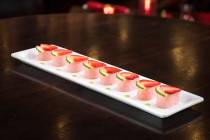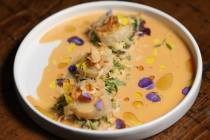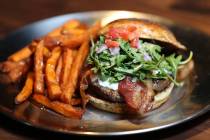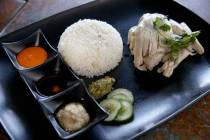Royal Persis
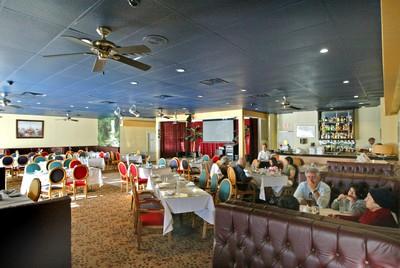
Whenever you can hear a knife going in a restaurant kitchen — chop, chop, chop, against something that sounds like a big, solid butcher block — it’s always a good sign. It means that whoever’s wielding the knife is busy prepping fresh food, as opposed to opening freezer packs to pop them into a microwave.
And that’s what we heard as we waited for dinner at Royal Persis. Somewhat early on a weeknight the place was quiet in every sense of the word, with the only other customers in the largish room two men with the bearing of expatriates, both of them dining alone. But a clue that things would pick up as the night wore on (and likely even more so on weekends) came from the stage setup at the front of the room.
As it happened, we had to wait at the door a bit for someone to show up, but once he did, he turned on recorded music (but softly) and was quite attentive for the rest of the evening — even when he had several more tables to serve, some of whom conversed with him in what we assumed was Farsi.
The name provides a clue that Royal Persis’ roots are Iranian, but like most valley restaurants that hail from the region it carries the sublabel of “Mediterranean,” which seems to be a little more user-friendly for Americans but in some cases is a bit of a stretch. Most of them have a number of dishes in common and it’s interesting to see the various tweaks, which can stem from the chef’s family tradition as much as from his or her provenance, the borderlines of these things being characteristically fuzzy.
Considering the Iranian ties, we were hoping the menu would include Fesanjan ($12.95), and indeed it did. It was an artfully wrought version, with crushed walnuts combining with pomegranate molasses as a sauce for boiled chicken (which sounded alarmingly bland, but the sauce was sufficiently assertive to take care of that) and served with a huge mound of basmati rice, its characteristic aroma wafting toward us.
The other dishes we sampled were less chauvinistic in nature. Dolemeh ($6.95) were a version of what the Greeks call dolmathes. There are as many interpretations of these stuffed grape leaves (some places have moved to the more generic “vine leaves,” but Royal Persis is sticking with grape), filled with a mix of rice, scallions and fresh herbs. These are sometimes served warm, sometimes chilled but these were at room temperature, which seemed to us just right.
Chelo kebab barg ($17.95) was a gourmet’s kebab, made of impossibly tender filet mignon, the flavor of which gained much from the charbroiled cooking technique. It, too, was accompanied by a huge pile of rice, plus a broiled tomato.
Shortly after we were seated we’d been brought a large basket of pita cut into squares, plus a bowl of butter pats. That the pita was heavily charred sounds like a bad thing but was exactly the opposite, the charring lending so much flavor to the bread that we happily chowed it down plain. It also served as an effective vehicle for the Moost’Moosier ($4.95) we ordered, which is hung (thickened) yogurt with chopped shallots, though they were overly mild.
The only weak link was the baklava, which was inherently decent enough but was served chilled and tasted vaguely of the fridge. Serving it at room temperature might help alleviate that situation.
Maybe they could remove a few pieces at a time and allow it to warm naturally? Because I think it’s a good bet that Royal Persis and its chop-chop-chopping chef don’t use a microwave.
Las Vegas Review-Journal reviews are done anonymously at Review-Journal expense. Contact Heidi Knapp RInella at 383-0474 or e-mail her at hrinella @reviewjournal.com.
HEIDI KNAPP RINELLAMORE COLUMNS what: Royal Persis
where: 2790 E. Flamingo Road
phone: 413-6017
overall: B
food: B
atmosphere: B
service: B
pluses: Good Iranian/Mediterranean food.
minuses: Yogurt a little bland.









